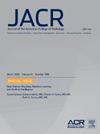Patient Photograph Association With Radiologist Recommendations for Additional Imaging
IF 4
3区 医学
Q1 RADIOLOGY, NUCLEAR MEDICINE & MEDICAL IMAGING
引用次数: 0
Abstract
Objective
Assess whether display of a patient photograph in the electronic health record (EHR) alongside head and neck CT or MRI radiology examinations is associated with recommendations for additional imaging (RAI) and whether self-reported race modifies that association.
Methods
This multi-institution health care system retrospective observational study from June 1, 2021 to May 31, 2022 included all patients with a head/neck CT or MRI report. We investigated association of photograph with RAIs using mixed-effects models adjusting for age, sex, complexity score, race, and area deprivation index while conditioning on patient and radiologist. Race was subsequently included as an interaction term. Multiple imputation was used as sensitivity analysis to address missing race data.
Results
In all, 60,543 reports were included from 48,143 patients (55.6% female; median age 58 years, interquartile range 40-70). The EHR included a photograph at the time 18.2% (11,048 of 60,543) of reports were signed. RAIs were included in 7.5% (4,522 of 60,543) of reports. Reports signed when a photograph was displayed had lower estimated odds of containing RAIs (odds ratio: 0.85, 95% confidence interval: 0.77-0.93, P < .001), consistent in sensitivity analysis, with no clear interaction between race and photograph (odds ratio: 0.99, 95% confidence interval: 0.69-1.46, P = .97).
Discussion
Patients with a photograph in the EHR had a lower probability of receiving RAIs and this difference did not seem to be the result of implicit racial bias but may be due to personalization of the encounter. This effect may influence radiology reporting for millions of patients per year. Further research is needed to determine whether the association has a positive or negative impact on care quality and outcomes.
患者照片与放射科医生建议进行额外成像的关联。
目的:评估在头颈部 CT 或 MRI 放射检查的同时在电子健康记录(EHR)中显示患者照片是否与额外成像(RAI)建议有关,以及自我报告的种族是否会改变这种关联:这项多机构医疗系统回顾性观察研究的研究时间为 2021 年 1 月 6 日至 2022 年 5 月 31 日,研究对象包括所有出具头颈部 CT 或 MRI 报告的患者。我们使用混合效应模型研究了照片与 RAI 的相关性,该模型调整了年龄、性别、复杂性评分、种族和地区贫困指数,同时对患者和放射科医生进行了调节。种族随后被列为交互项。多重估算作为敏感性分析用于解决种族数据缺失的问题:共纳入 48,143 名患者(55.6% 为女性;中位年龄 58 岁,IQR 40-70)的 60,543 份报告。18.2%(11,048/60,543)的报告签署时电子病历包含照片。7.5%(4522/60543)的报告包含 RAI。显示照片时签署的报告含有 RAI 的估计几率较低(OR:0.85,95%CI:0.77-0.93,p 讨论:电子病历中有照片的患者接受 RAI 的几率较低,这种差异似乎不是隐性种族偏见造成的,而可能是由于就诊的个性化。这种效应可能会影响每年数百万患者的放射报告。还需要进一步的研究来确定这种关联对医疗质量和治疗效果的影响是积极的还是消极的。
本文章由计算机程序翻译,如有差异,请以英文原文为准。
求助全文
约1分钟内获得全文
求助全文
来源期刊

Journal of the American College of Radiology
RADIOLOGY, NUCLEAR MEDICINE & MEDICAL IMAGING-
CiteScore
6.30
自引率
8.90%
发文量
312
审稿时长
34 days
期刊介绍:
The official journal of the American College of Radiology, JACR informs its readers of timely, pertinent, and important topics affecting the practice of diagnostic radiologists, interventional radiologists, medical physicists, and radiation oncologists. In so doing, JACR improves their practices and helps optimize their role in the health care system. By providing a forum for informative, well-written articles on health policy, clinical practice, practice management, data science, and education, JACR engages readers in a dialogue that ultimately benefits patient care.
 求助内容:
求助内容: 应助结果提醒方式:
应助结果提醒方式:


